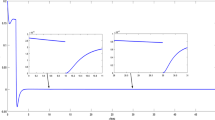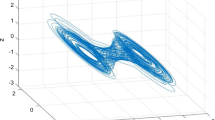Abstract
This paper examines various constraints of networked control systems (NCSs) such as network-induced random delays, successive packet dropouts and Poisson noise. Time delays are represented as modes of Markov chain and successive packet dropouts are modeled using Poisson probability distribution. For each delay-mode, a separate Poisson distribution is used with the help of an indicator function. Poisson noise is incorporated in the design to cater sudden network link failures and power shutdowns. After modeling these constraints, a stability criterion is proposed by using Lyapunov-Krasovskii functional. On the basis of the stability criteria, sufficient conditions for the existence of a robust H ∞ state feedback controller are given in terms of bilinear matrix inequalities (BMIs). Later, BMIs are converted into quasi-convex linear matrix inequalities (LMIs) and are solved by using a cone complementarity linearizing algorithm. The effectiveness of the proposed scheme is elaborated with the help of two simulation examples. Moreover, the effects of successive packet dropouts and Poisson noise on H ∞ performance are analyzed.
Similar content being viewed by others
References
Y. Shi and B. Yu, “Robust mixed H 2/H ∞ control of networked control systems with random time delays in both forward and backward communication links,” Automatica, vol. 47, no. 4, pp. 754–760, 2011.
Y. Ishidoa, K. Takabaa, and D. E. Quevedob, “Stability analysis of networked control systems subject to packet-dropouts and finite-level quantization,” Systems & Control Letters, vol. 60, no. 5, pp. 325–332, 2011.
F. Rasool, D. Huang, and S. K. Nguang, “Robust H ∞ output feedback control of discrete-time networked systems with adaptive quantizers,” Proc. of CDC-ECE, pp. 2381–2386, 2011.
S. Chae, F. Rasool, S. K. Nguang, and A. Swain, “Robust mode delay-dependent H ∞ control of discrete-time systems with random communication delays,” IET Control Theory and Applications, vol. 4, no. 6, pp. 936–944, 2009.
F. Yang, W. Wang, and Y. Li, “An iterative LMI approach to H ∞ networked control with random communication delays,” International Journal of Systems, Control and Communications, vol. 1, no. 3, pp. 325–341, 2009.
D. Huang and S. K. Nguang, “State feedback control of uncertain networked control systems with random time-delays,” IEEE Trans. on Automatic Control, vol. 53, pp. 829–834, 2008.
L. Ma, F. Da, and K.-J. Zhang, “Exponential H ∞ filter design for discrete time-delay stochastic systems with Markovian jump parameters and missing measurements,” IEEE Trans. on Circuits and Systems I: Regular Papers, vol. 58, no. 5, pp. 994–1007, 2011.
L. Teng, P. Wen, and W. Xiang, “Model-based networked control system stability based on packet drop distributions,” Proc. of 10th International Conference on Control, Automation, Robotics and Vision, pp. 488–493, 2008.
J. J. Westman and F. B. Hanson, “State dependent jump models in optimal control I,” Proc. of IEEE Conference on Decision and Control, vol. 3, pp. 2378–2383, 1999.
I. Kolmanovsky, Ford Motor Co Res Lab, M. I. Dearborn, and T. L. Maizenberg, “Optimal containment control for a class of stochastic systems perturbed by Poisson and Wiener processes,” Proc. of the American Control Conference, vol. 1, pp. 322–327, 2002.
S. Kalpakama and K. P. Sapnaa, “A control policy of an inventory system with compound Poisson demand,” Stochastic Analysis and Application, vol. 11, pp. 459–482, 1993.
K. Zhou and P. Khargonekar, “Robust stabilization of linear systems with norm-bounded time-varying uncertainty,” Systems and Control Letters, vol. 10, pp. 17–20, 1988.
S. Zhou, J. Lame, and W. X. Zheng, “Control design for fuzzy systems based on relaxed non quadratic stability and H ∞ performance conditions,” IEEE Trans. on Fuzzy Systems, vol. 15, no. 2, pp. 188–199, 2007.
X.-G. Guo, G.-H. Yang, and W.-W. Che, “Insensitive dynamic output feedback control with mixed-H ∞ norm sensitivity minimization,” Journal of the Franklin Institute, vol. 350, no. 1, pp. 72–91, 2013.
L. Xiao, A. Hassibi, and J. P. How, “Control with random communication delays via a discrete-time jump system approach,” Proc. of the American Control Conference, pp. 2199–2204, 2000.
A. P. C. Goncalves, A. R. Fioravanti, and J. C. Geromel, “Dynamic output feedback H ∞ control of discrete-time Markov jump linear systems through linear matrix inequalities,” Proc. of the 47th IEEE Conference on Decision and Control, pp. 4787–4792, 2008.
L. Ghaoui, F. Oustry, and M. AitRami, “A cone complementarity linearization algorithm for static output-feedback and related problems,” IEEE Trans. on Automatic Control, vol. 42, no. 8, pp. 1171–1176, 1997.
S. Sun, L. Xie, W. Xiao, and N. Xiao, “Optimal filtering for systems with multiple packet dropouts,” IEEE Trans. on Circuits and Systems II: Express Briefs, vol. 55, no. 7, pp. 695–699, 2008.
H. Hamidian and A. Jalali, “Calculation of PID controller parameters for unstable first order time delay systems,” International Journal of Scientific and Engineering Research, vol. 3, no. 3, March 2011.
Author information
Authors and Affiliations
Corresponding author
Additional information
Faiz Rasool received his B.E degree (with first class honors) from CIIT, Pakistan, his M.E. (with first class honors) and Ph.D. degrees from the Department of Electrical and Computer Engineering of the University of Auckland, New Zealand. At the moment, he is the program leader Engineering department, Queens Academic Group, Auckland, New Zealand. He has published over 24 refereed journal and conference papers on Networked control systems, time-delayed systems, Event- triggered control and fuzzy modeling and control.
Sing Kiong Nguang received his B.E. (with first class honors) and his Ph.D. degree from the Department of Electrical and Computer Engineering of the University of Newcastle, Callaghan, Australia, in 1992 and 1995, respectively. Currently, he is a chair professor at the Department of Electrical and Computer Engineering, University of Auckland, Auckland, New Zealand. He has published over 250 refereed journal and conference papers on nonlinear control design, nonlinear control systems, nonlinear time-delay systems, nonlinear sampled-data systems, biomedical systems modeling, fuzzy modeling and control, biological systems modeling and control, and food and bioproduct processing. He has/had served on the editorial board of a number of international journals. He is the Chief-Editor of the International Journal of Sensors, Wireless Communications and Control.
Rights and permissions
About this article
Cite this article
Rasool, F., Nguang, S.K. Robust H ∞ state feedback control of NCSs with Poisson noise and successive packet dropouts. Int. J. Control Autom. Syst. 13, 45–57 (2015). https://doi.org/10.1007/s12555-013-0139-0
Received:
Revised:
Accepted:
Published:
Issue Date:
DOI: https://doi.org/10.1007/s12555-013-0139-0




